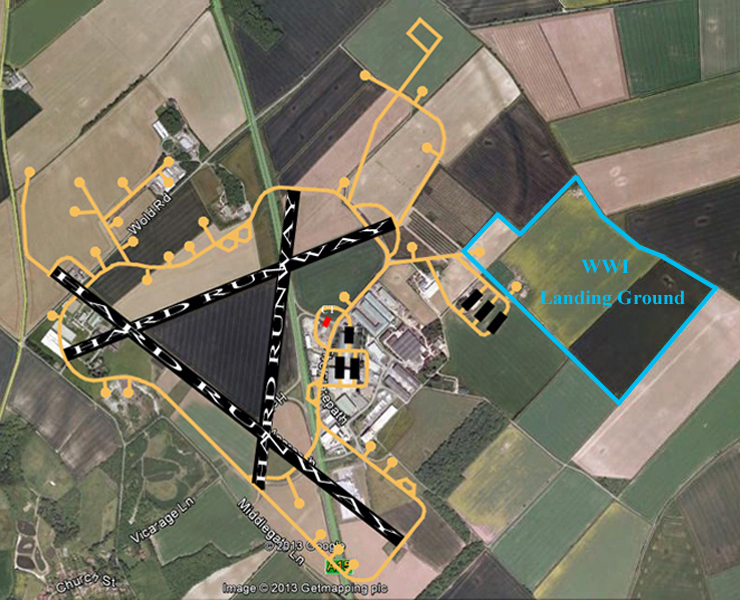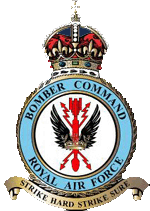Elsham Wolds Airfield History

(Map edited to show the airfield and runways 1940-45)

© Crown Copyright/MOD 2010
53°36'28.0"N 0°25'40.2"WRunways:
02/20 4200ft x 150ft - 08/26 4800ft x 150ft - 14/32 6000ft x 150ft
The wide expanse of grazing pasture on Elsham Wolds, lying some nine miles south of Hull on the Lincolnshire side of the Humber, was first utilised as an airfield in 1916 when No.33 Squadron, RFC, with its F.E.2b and F.E.2d biplanes was deployed between Hull and Lincoln to counter the Zeppelins coming in over the Lincolnshire coast during their night raids on the Midlands. While Gainsborough served as a headquarters, the limited endurance of the F.E.2s necessitated No.33 Squadrons complement being split into three flights and placed at RAF Kirton in Lindsey, RAF Scampton and Elsham Wolds roughly 12 miles apart in a line between the two cities. Elsham Wolds served C Flight which arrived in December 1916 and stayed until June 1918, flying many sorties to try to counter the Zeppelin raids but without success. Wooden huts and a small aircraft shed were erected but had been demolished by 1919 when the wold was returned to cattle and sheep after the war.
In the late 1930s, with the threat of another war, there was a requirement to find new airfield sites for RAF expansion. The 1914-1918 locations were some of the first reviewed but at Elsham Wolds an area to the west of the earlier site was found more suitable. Preparations did not begin until the winter of 1939-1940 and were not completed until the summer of 1941 owing to the decision to put down hard runways before the station was opened and these were then extended. Initially 27 hardstandings were provided, later increased to 36, which comprised three loops and the rest pans. The technical site with one Type J hangar and two T2s was built on the east side of the airfield. Three Type T2s were erected early in 1944 to serve No.13 Base Maintenance. These were on a spur that ran to the edge of the First World War aerodrome site, south of runway head 28. Domestic sites for up to 2,068 males and 493 females were dispersed in adjoining farmland to the southeast. Bomb stores were located off the northeast side of the airfield.
In July 1941 No.103 Squadron and its Wellingtons arrived from RAF Newton for operations, the first sorties from Elsham Wolds being flown on the night of the 24th. In the following spring the squadron began conversion to Halifax’s. However, this association was brief for no sooner had No.103 taken the Halifax to battle in July 1942, than 1 Group embarked on all Lancaster re-equipment and by October the Halifax’s had been withdrawn. In November 1943, No.103 shed its C Flight which expanded to become No.576 Squadron. The new squadron and its Lancaster's remained until October 1944 when they moved to RAF Fiskerton, that station being transferred from 5 Group. No.100 Squadron's Lancaster's were moved in from RAF Waltham (Grimsby) during the last month of the war, supposedly due to deterioration of that airfield's runways.
Only one other Bomber Command squadron had a longer association with one airfield during wartime than No.103 Squadron for it remained at Elsham Wolds until six months after VE-Day. No.103 Squadron is credited with more operational sorties than any other 1 Group squadron but consequently it suffered the group's highest losses and of the 248 bombers lost on operations while flying from Elsham Wolds, 198 were from No.103 Squadron. Of the 248 total, 28 comprised Wellingtons, 12 Halifax's and 208 Lancaster's. One Elsham Wolds Lancaster, ED888, which served with both Nos.103 and 576, held the Bomber Command record for operational sorties having completed 140 between May 1943 and December 1944.
The Lancaster squadrons departed for RAF Scampton's permanent and more comfortable camp in December 1945, No.l03 having been re-numbered No.57 in one of those insensitive number-juggling exercises in which the Air Ministry frequently indulged. Their place at Elsham was taken by No.21 Heavy Glider Conversion Unit of Transport Command which exercised with Halifax and Albemarle tugs and Horsa gliders for nearly a year, before its personnel too were given superior accommodation at RAF North Luffenham. This marked the end of Elsham Wolds as a military airfield, the land soon being returned to agriculture and many of the buildings employed for commercial enterprises.
RAF Elsham Wolds was closed in 1947 and shortly afterwards DP's (Displaced Persons), Poles and Ukrainians started to squat in the buildings whilst working at the Scunthorpe Steelworks. Some contemplated transit to the US or Canada, others to set roots, mostly in Scunthorpe. Colloquially, it started to be known as "Warsaw Hamlet" and the Post Office delivered letters using that address. By late 1952 early 1953 the DP's had moved on and once again the site reverted to first agriculture use and later as the site of an industrial estate. The history of the site is reflected in the road names on the estate which include Halifax Approach and Wellington Way.
In 1970s, the new A15 dual carriageway road linking the M180 with the Humber Bridge was taken across the old airfield site. During the same period a water treatment works was built near the A15. The control tower at Elsham Wolds lasted into the 1980s and was used as a house for a time, which it was said to be haunted. The J-Type hangar is still standing.
| Date | Squadron | Notes |
|---|---|---|
| 1916 | Station Opens. | |
| January 1917 | No.33 Sqn | Operating the Royal Aircraft Factory F.E.2. The Squadron disbanded in June 1918. |
| 1919 | Station closed. | |
| July 1941 | Station re-opens. | |
| July 1941 | No.103 Sqn | Operating the Vickers Wellington, Handley Page Halifax and Avro Lancaster. Re-numbered to No.576 Squadron in November 1945. |
| October 1942 | No.1656 HCU | Operating the Handley Page Halifax. Left Elsham in November 1942. |
| November 1943 | No.576 Sqn | Operating the Avro Lancaster. Left Elsham in October 1944. |
| December 1945 | No.21 HGCU | Operating the Handley Page Halifax, Airspeed Horsa and Armstrong Whitworth Albemarle. Left Elsham in November 1946. |
| April 1945 | No.100 Sqn | Operating the Avro Lancaster. Left Elsham in December 1945. |
| 1947 | RAF Elsham Wolds closed. |
